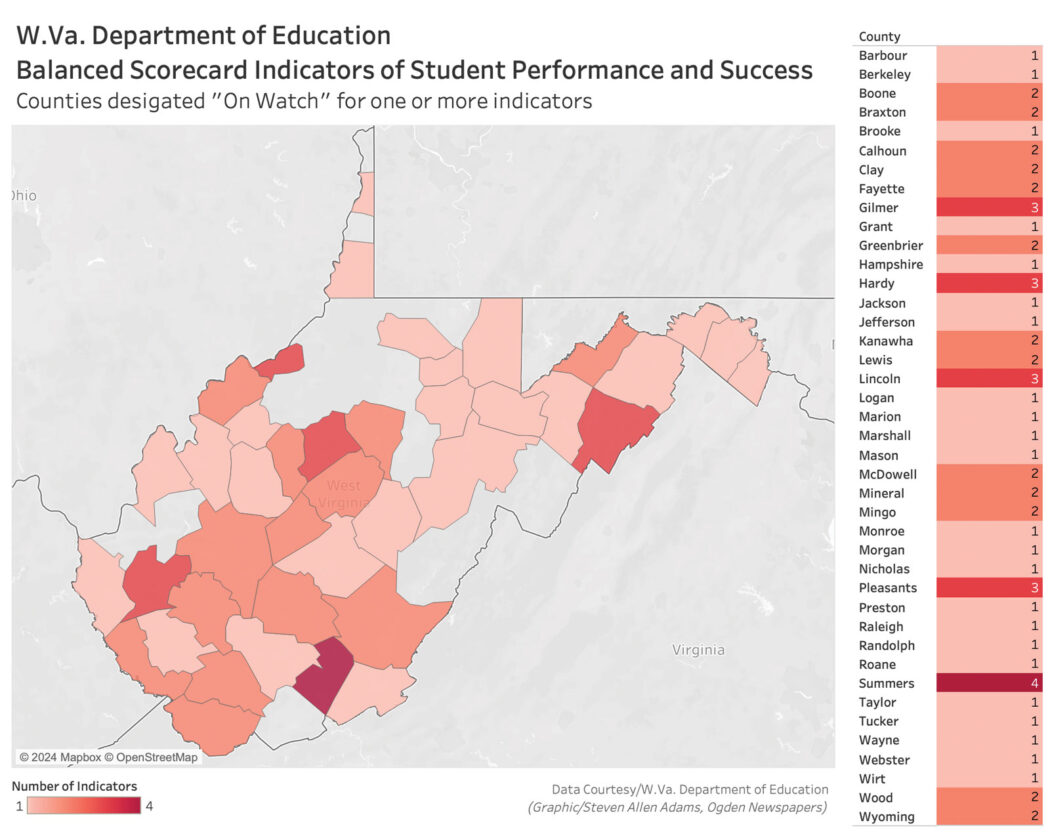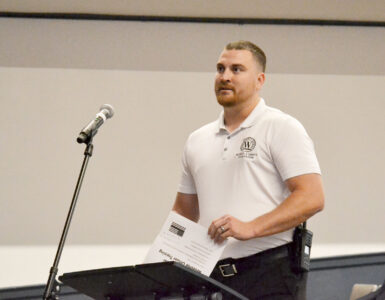Some county school systems in West Virginia come off ‘On Watch’ list

(Graphic by Steven Allen Adams)
CHARLESTON — A new report from the West Virginia Department of Education shows some counties coming off an “on watch” category for not meeting student performance and success indicators. The Department of Education’s Office of Accountability released its annual report on County Approval Status and Accreditation, presenting the report Wednesday to the state Board of Education. The Office of Accountability reviews all counties on an annual basis, looking at the Balanced Scorecards and efficiency indicators for county school system operational effectiveness. “We’re charged as a state with providing a thorough and efficient education to our West Virginia children and these two datasets provide county level information with regard to those two standards, thoroughness and efficiency,” said Alexandra Criner, director of the Office of Accountability. Last year, 49 out of 55 counties were considered “on watch” for not meeting one or more standards in the following areas: English Language Arts (ELA) achievement and program, math achievement and progress, English learners progress, attendance, behavior, four-year and five-year graduation rates, students on-track to graduation, and post-secondary achievement. In this year’s report, the number of counties considered “on watch” dropped to 41 counties. There are 11 counties on watch for not meeting ELA achievement standards, and 17 counties are on watch for not meeting math achievement standards. But Criner said the challenge facing most of the counties considered on watch was student attendance, defined as the percentage of students who are missing more than 10% of the school year. Criner said there has been some improvement from last school year’s report, but attendance remains a problem. According to the report, 22 counties are on watch for attendance, while another 20 are considered in need of support, meaning that the counties did not meet attendance standards for two years in a row. According to Criner, 91% of counties that were designated on watch last year showed a reduction in chronic absenteeism in 2024. There were no counties listed as needing “intensive support” for not meeting attendance standards, meaning the county did now show for three years in a row. “Attendance was one of our highlighted indicators from last year that revealed that there was an issue with chronic absenteeism that really needed to be addressed,” Criner said. “When we look at the number of districts that are either on support or on watch for that, it is evident that a lot of the efforts that we’ve made in that area have paid off.” Criner said that all of the counties that were designated “support” for last year and made a reduction in their chronic absenteeism rate are staying on support instead of not being downgraded to “on watch” counties. “The reason they’re not moving back to ‘on watch’ or fully approved, even though they’ve made progress, is that once you are in a designation and you come up with a plan to address the requirements of that designation, you stay there until you partially meet standard for that indicator,” Criner said. “So, as long as that improvement is working, we are not going to increase the stage on that. We’re going to allow districts time to implement those plans and make improvements with the expectation that yearly they’re going to report better data.” No counties were designated as “support” or “intensive support” in ELA achievement. In regard to math achievement, 65% of counties that were on watch last year made gains this year, and 22% of counties designated “support” last year made gains in math achievement. But seven counties failed to make progress in math, receiving the designation of “intensive support.” County operational effectiveness looks at 11 indicators in a county, including career and technical education, child nutrition, the effectiveness of county boards of education, facilities, federal programs, finance, personnel, special education, state-required data collections, transportation, and universal pre-Kindergarten readiness. There were 35 out of 55 counties designated as counties needing assistance with one or more county operational effectiveness indicators. Three counties need assistance with universal pre-K readiness. Three counties need assistance for career and technical education. Two counties need assistance for county board of education member effectiveness. Eight counties need assistance with finance. Five counties need assistance with federal programs. Counties that are continually designated in the “needs assistance” category for county operational effectiveness or the “support” and “intensive support” indicators receive greater assistance from the Department of Education, including action plans to make needed improvements. The state Board of Education can also order the department to directly intervene in counties, such as what was done in Logan and Upshur counties. Most of the counties fell under a “needs assistance” category for special education and personnel, with 21 counties needing assistance for special education based and 15 counties needing assistance for personnel. But Criner said the data on personnel is dependent on information supplied by counties into the state’s Educational Information System, or WVEIS. “They are a reflection of the number of teachers who are registered to a core course – math, science, language, arts, social studies – who are certified in that area. It is highly dependent upon accurate data entry,” Criner said. Just because we have a county currently identified as ‘needs assistance ‘for personnel, that does not necessarily reflect that they have uncertified teachers in those positions. It may be an issue of incorrect coding in the WVEIS system.” But Dale Lee, president of the West Virginia Education Association, told state Board of Education members Wednesday that county school systems are in desperate need of teachers and staff. “We have a shortage in teachers, aides, bus drivers, cooks, custodians. You name it, we have those shortages,” Lee said. “We don’t have enough counselors to go around. We don’t have enough social workers in our schools.” Micky Blackwell, executive director of the West Virginia Association of Principals, criticized the recent special session of the West Virginia Legislature, which appropriated more than $500 million in surplus tax collections and passed a 2% personal income tax cut paid for in part with $27 million in savings from the split up of the former Department of Health and Human Resources. Blackwell said if there are additional monies, they should be put into education. “If they take that $20 million and put it into schools, put it into administrators, put it into counselors, we would be serving the children of West Virginia who are going to grow up to be our future taxpayers,” Blackwell said. “So please, let’s all get together. We know January’s coming and let’s start making plans now to be as supportive of our principals, be as supportive of each other, and support our legislators to help them see what our schools need.” Steven Allen Adams can be reached at sadams@newsandsentinel.com

